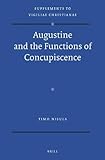Augustine and the Functions of Concupiscence.
Material type: TextSeries: Vigiliae Christianae, SupplementsPublisher: Leiden : BRILL, 2012Description: 1 online resource (433 pages)Content type:
TextSeries: Vigiliae Christianae, SupplementsPublisher: Leiden : BRILL, 2012Description: 1 online resource (433 pages)Content type: - 9789004233447
- 900423344X
- 9004231684
- 9789004231689
- Augustine, of Hippo, Saint, 354-430
- Augustine, of Hippo, Saint, 354-430
- Lust -- Religious aspects -- Christianity -- History of doctrines -- Early church, ca. 30-600
- Sex -- Religious aspects -- Christianity -- History of doctrines -- Early church, ca. 30-600
- Emotions -- Religious aspects -- Christianity -- History of doctrines -- Early church, ca. 30-600
- RELIGION -- Christian Theology -- Ethics
- RELIGION -- Christian Theology -- Anthropology
- 30-600
- 233.4 233/.4 241.3
- BR65.A9 N57 2012
- online - EBSCO
| Item type | Current library | Call number | URL | Status | Notes | Barcode | |
|---|---|---|---|---|---|---|---|
 eBook
eBook
|
Biblioteca "Angelicum" Pont. Univ. S.Tommaso d'Aquino Nuvola online | online - EBSCO (Browse shelf(Opens below)) | Online access | Not for loan (Accesso limitato) | Accesso per gli utenti autorizzati / Access for authorized users | (ebsco)480584 |
Print version record.
In Augustine and the Functions of Concupiscence, Timo Nisula offers a comprehensive analysis of Augustine's developing views of sinful desire. The book demonstrates how and why concupiscence became such a pregnant concept in Augustine's theology and philosophy.
Includes bibliographical references and indexes.
Augustine and the Functions of Concupiscence; Copyright; Dedication; Contents; Preface; Abbreviations; 1. Introduction; 1.1. The Task of the Study; 1.2. The Sources of the Study; 1.3. Lines of Research on Concupiscentia; 1.4. Methodological Considerations; 1.5. Outline of the Study; 2. The Language of Desire; 2.1. Roman Literature and Libido, Cupiditas, Concupisco; 2.1.1. Historical Writing; 2.1.2. Philosophical Writing; 2.2. Latin Christian Literature; 2.3. Augustine; 2.3.1. Some Lexical Remarks; 2.3.2. Augustine's Semantic Reflections; 2.3.3. Synonymy; 2.3.4. Textual Contexts.
2.4. Conclusion3. Paradise and Punishment; 3.1. Probing for the Connection between Divine Punishment and Concupiscentia; 3.2. Stabilizing Reciprocal Punishment; 3.2.1. Disobedience; 3.2.2. Justice; 3.2.3. Rhetorical Aesthetics of Punitive Concupiscence; 3.3. Defending Divine Punishment and Divine Justice; 3.3.1. Starting the Defence -- nupt. et conc. and c. ep. Pel.; 3.3.2. An Escalating Conflict -- c. Iul. and c. Iul. imp.; 3.4. Conclusion; 4. The Root and Matrix of Sin; 4.1. Cupiditas and Caritas -- An Overview; 4.2. Cupiditas As the Root of All Sin; 4.3. Concupiscentia As the Matrix of Sin.
4.4. Conclusion5. Concupiscentia and Philosophical Traditions of Emotions; 5.1. Emotions, Libido and Anti-Manichaean Apology (388-396); 5.2. Continuities and Interludes; 5.2.1. Affective Confessions; 5.2.2. Contra Faustum; 5.2.3. De Trinitate; 5.3. Critical Reflections -- De Ciuitate Dei and the Debate with Julian of Aeclanum (410-430); 5.3.1. De Ciuitate Dei 9 and 14; 5.3.2. Critical Encounters with Philosophy, Emotions, and Christian Psychology in the Debate with Julian of Aeclanum; 5.4. Conclusion; 6. Grace and Renewal -- The Domestication of Concupiscentia; 6.1. Introduction.
6.2. Disavowing Concupiscentia -- Vague Beginnings6.3. Inuictissima Cupiditas -- In Search of the Effects of Grace; 6.4. Relocating Concupiscentia -- The First Phase of the Pelagian Debate; 6.5. Encountering Caricatures -- The Second Phase of the Pelagian Debate; 6.5.1. Resistibility; 6.5.2. Interiority in Christian Life; 6.5.3. Real Effects of Baptism; 6.5.4. Romans 7; 6.6. Last Meanderings with Julian -- Resistibility and Necessity; 6.6.1. Resistibility and the Real Effects of Baptism; 6.6.2. Romans 7; 6.6.3. Christ As a Model for Renewal; 6.7. Conclusion; 7. Conclusion; Bibliography; Sources.
1. Augustine2. Other Sources; 3. Translations; Studies; Index of Modern Authors; Index of Subjects and Names; Index of Ancient Sources.


